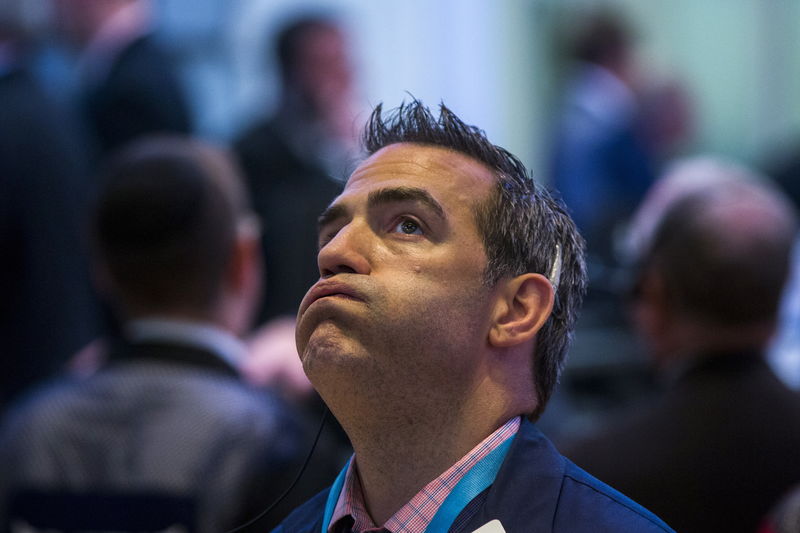Investing.com – Stocks finished the week on a down note on slumps in Boeing and Johnson & Johnson, plus new worries about Chinese economic growth.
The S&P 500 was off 0.39%. But the Dow Jones industrials slumped 0.95%, or more than 255 points, and the Nasdaq Composite dropped 0.83%.
Just about all of the Dow's decline was due to Boeing's (NYSE:BA) 6.8% loss and a 6.2% decline for Johnson & Johnson (NYSE:JNJ). The two subtracted more than 227 points from the price-weighted blue-chip index.
The higher a stock's price, the more impact it has on the index. And gains for other stocks can be overshadowed by a big more from a stock with a big price.
In fact, 14 of the 30 stocks were higher, with Coca-Cola (NYSE:KO), up 1.8% on the better-than-expected third-quarter results, and Verizon Communications (NYSE:VZ), up 1.06%.
Boeing's slump came after Reuters reported that text messages between two employees suggested the planemaker misled the Federal Aviation Administration about the safety of the grounded 737 MAX aircraft.
Johnson & Johnson fell after announcing it would recall baby powder in the United States after regulators found trace amounts of asbestos in a sample
The S&P 500, meanwhile, finished under 3,000 for the 21st-straight session.
The Nasdaq was weighed down by weakness in tech stocks, especially chip stocks. The Philadelphia Semiconductor Index dropped 1.06%, in large part due to worries about China, which reported its GDP growth rate dropped to 6% year over year, its weakest pace in nearly 30 years. The slide is largely the effect of the U.S.-China trade fight.
Thanks to the Dow's drubbing on Friday, the index ended the week down 0.17%, its fourth weekly loss in five weeks. The S&P 500, far more diverse, was up 0.54% for the week, its second-straight gain. The Nasdaq added 0.4%, its third weekly gain in row.
For the year, the Dow is up nearly 14.8%. The S&P 500 is up 19.1%, with the Nasdaq up 21.9%.
The necessary caveat is that the gains came mostly in the first quarter as the market recovered from last fall's big dive.
The Dow is off 0.67% from its 2018 peak, along with a 0.54% decline from the same peak for the Nasdaq. The S&P 500 is up 1.54%.
But the worries weighed on the Dow and the S&P 500 as well because so many U.S. companies have looked to China as a major source of new sales.
Seven of the 11 S&P sectors were lower, but there was considerable strength in real estate, financial and utility stocks as interest rates were flat to lower.
The 10-Year Treasury yield fell to 1.75% from Thursday's 1.755%, It could go lower if the Federal Reserve cuts interest rates at its Oct. 29-30 meeting. The odds of that happening stood at nearly 90% late Friday.
Apartment companies, including AvalonBay Communities (NYSE:AVB) and Apartment Investment and Management (NYSE:AIV), hit new highs, along with Home Depot (NYSE:HD) and Whirlpool Corporation (NYSE:WHR), hit new highs.
Other stocks hitting new highs included Celgene (NASDAQ:CELG), Crocs (NASDAQ:CROX), Nike (NYSE:NKE) and Kansas City Southern (NYSE:KSU).
Apple (NASDAQ:AAPL), up 0.48% on the day, ended the week as the most valuable company in the world with a $1.068 trillion market capitalization. Microsoft (NASDAQ:MSFT), down 1.63% on Friday, ended with a $1.048 trillion market cap.
Robotic surgical-equipment maker Intuitive Surgical (NASDAQ:ISRG), investment manager State Street (NYSE:STT), brokerage ETrade (NASDAQ:ETFC) and New England bank People’s United Financial (NASDAQ:PBCT) were among the top S&P 500 performers.
Women's apparel maker L Brands (NYSE:LB), Boeing (NYSE:BA), Johnson & Johnson (NYSE:JNJ) and Netflix (NASDAQ:NFLX) were among the weakest S&P 500 performers.
Oil prices moved lower. West Texas Intermediate crude fell to 15 cents to $53.78 a barrel. Brent crude fell 49 cents to $59.42.
Gold futures fell to $1,494.10 an ounce in New York, down $4.20.
